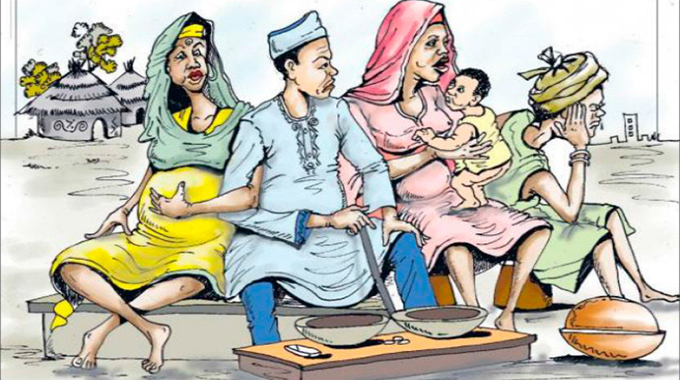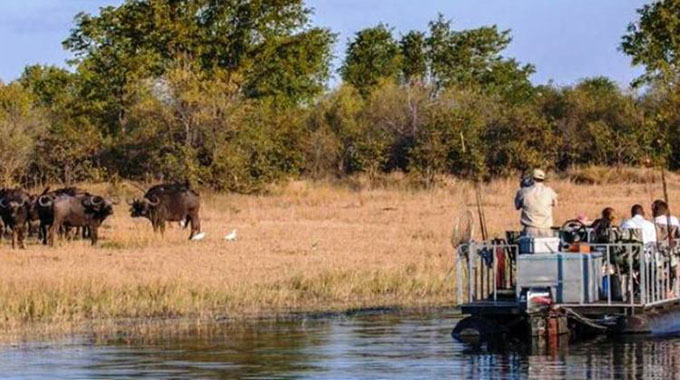UNWTO Gen Assembly’s last natural vestige of wildlife
Isdore Guvamombe
Wafting air atones for nothing other than the hair-raising timid smell of the wilderness, sending a flashing chill down the spine.
Butterflies flirt in the mottled sunlight, while ordinary flies hover above dotted animal droppings, a stark declaration that they are part of the ecological cycle of this last vestige of wilderness. Baboons and monkeys preen each other’s glossy coats in concentrated huddles, chatter and squabble noisily among themselves.
Others bounce effortlessly into the trees, systematically swinging nonchalantly through tree branches. The huge male baboon, slowly and tentatively moves out of the road, clear in its intention as the last bloc in the line of defence and unexpectedly shouts, “bohoom!” as if it was an obscenity targeted at us.
Confident in the camouflage of their stripes at this predatory hour, zebra pose in front of our vehicle — a modest Toyota Rav 4 — for our pleasure, heads aligned, stripes merging and flowing in motion, displaying their magnificent God-given colours. Formidable herds of buffalo moo, flap their ears, nose up and defiantly spatter the ground with dung before boastfully moving off the road.
A spitting distance away, a pair of giraffes race along the road — all legs and neck — yet looking elegant in their gangling awkwardness. Protective elephant huddle and guard their young calves under the shed of a fat baobab tree.
The huge mounds of grey flesh make our car look like a dwarf under the armpit of a giant colossus.
Slowly, tentatively, they reluctantly move off the road and we proceed to the lodges, along the Zambezi River. Unknown to us, the jumbos were later to perform the greatest spectacle — three adventurous ones —decided to cross the Zambezi River, body submerged, trunk up above the murky waters.
What a spectacle! Only the lucky ones could have this experience on a sunset cruise under the silhouetted horizon. Boats sped in the direction of the elephants as they trudged the rocky riverbed bottom in an epic crossing to Zambian islands.
Further scouring the vast wilderness of rocky outcrops and wooded hillocks, the shy kudu’s corkscrew horns gleam like worn metal behind a camouflage of thorny thicket.
Panic-stricken, the kudu gallops for dear life, head up, horns subconsciously tilted backwards to form a fleshy flying spear. For lack of diction, this is the best description of Zambezi National Park in the Victoria Falls.
This is arguably the last vestige of Zimbabwe’s natural beauty and is a must-visit by any discerning and — loving tourist before cooling it off at the falls themselves.
Wildlife is concentrated along the mighty Zambezi River, the park’s lifeblood. Home to hippo and crocodiles snacking on schools of fish, Zambezi is a flooded torrent after the rains. On its banks, waterbuck, impala, duiker, gazelle and kudu among others risk their lives for a sip of its waters, a permanent hunting ground for crocodiles, lions, leopards, jackals, hyenas and packs of wild dogs.
The Zambezi National Park consists of 40km of Zambezi River frontage and a spread of wildlife, rich inland mopane forest and savanna and together with the Victoria Falls, cover an area of 56 000 hectares.
The northern front is the Zambezi River, the border between Zambia and Zimbabwe. The most fascinating aspect is that a larger number of varieties of large mammals, are found in the national park including the Big Four —elephant, lion, leopard and buffalo. Of course, the rhino has been removed to avert poaching.
Herds of sable antelope, kudu, impala, eland, zebra, giraffe and waterbuck are common in the park, especially near the lodges that stretch the river frontage as they seek a sip or two.
From the window of the lodges, we could easily see virtually all the animals mentioned much to our amusement. This is not a place to stay with the faint-hearted, because this is intrinsically a bush experience just on the outskirts of Victoria Falls town. The journey to the falls cannot be complete without visiting or staying at the Zambezi National Park where completely furnished self-catering lodges provide a family experience in the jungle.
The two-bedroom lodges with hot water, fridge, cooking stove and cutlery also have outside braai and cooking stands and are located on the river bank, 6km upstream the Victoria Falls.
The lodges are serviced by a tarred road, which has become dotted with elephant, buffalo and zebra dung.
Using outside facilities needs one to continuously check on the frolicking animals. There are three exclusive fishing camps — Kandahar, Mplala Jena and the Siansimba — are carefully located on fishing spots, just of the game driver road network. At the fishing camps are flush toilets, cold showers, tap water, sleeping shelter, cement tables with benches and braai stands. Fishing by boat is also exciting at these camps.
If one really wishes for an unforgettable wilderness experience, there are four campsites, situated on the banks of the Zambezi River, unfenced and completely in the wild. They are bush toilets and braai stands only. Chundu 1 is 31km upstream from the falls, Chundu 2 — 32km, Chomuzi 46km and Siamunungu is 51km.
Each camp can accommodate up to 12 people. There are also 25 picnic sites dotted in the park and sheltered under the riverine vegetation. One of the most outstanding experiences at Zambezi National Park is the lion encounter in the Chemabondo vicinity where tourists have a rare opportunity to work with lions whose ages vary from four weeks old cubs to 18 months-old adults.
To me that was a spine chilling experience walking alongside the king of the jungle. There we were, walking and patting the backs of Thuli and Thembile, the 17 months old predators. It was a rare spectacle. You really needed the guts, given the predatory instincts and once you have done the walk, you feel you have conquered the jungle.
The world become nothing threatening to you as nothing could be more dangerous than walking with the real king, that could easily turn you into prey within seconds. Exciting!
Then there are helicopter rides at Chikopokopo Helicopters in Zambezi National Park, where the popular Flight of the Angel, gives the tourists a bird’s eye view of the Victoria Falls and leave memorable imprints of what “angels on their flight to Heaven must have gazed and seen”. The helicopter flight takes about 15 minutes and is a good experience that gives rare photographic opportunities.
The Victoria Falls might be the biggest tourist attraction in that area, but one can never claim to have tested the sincerity of the African jungle and wildlife until he or she wanders into the Zambezi National Park.
This is a must visit. Delegates to the World Tourism Organisation General Assembly are up for a big treat at the Zambezi National Park, during the week long gathering. There is no doubt that the Zambezi National Park will give delegates to the UNWTO general assembly the feel of Africa. It is the epicentre of the jungle.







Comments